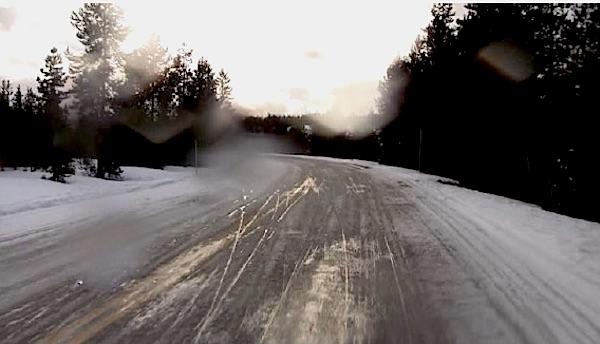
These poor snow conditions in Yellowstone, photographed in February, might reflect the new norm, not merely an aberration, according to snowpack research in the park.
This past winter saw an earlier-than-usual decline in snowpack on Yellowstone National Park roads, one that forced the park to shut down access to some snowmobilers and snowcoaches. While some might write that off to simply an unseasonal winter, record-keeping in the park shows less snow is falling there and that in some parts of Yellowstone the once-typical Rocky Mountain winter is actually much shorter than it used to be.
One can debate whether this is simply a natural cycling of the Earth's climate or human-driven global warming -- Yellowstone researchers point to the latter -- but the bottom line, as they note, is that "(D)espite all these caveats and complications, we are confident in saying the long-term forecast in Yellowstone calls for less snow. There may be a few decades-long bumps and flat places in the trend, but the overall picture of a declining staircase is clear. People who rely on water that begins its life as snow in the mountains of Yellowstone should be aware of this fact and plan accordingly."
The snowfall study was released this week in a special climate change edition of Yellowstone Science. The issue offers a range of articles involving climate change in Yellowstone, from the trends in snowfall to how the park's forests will fare under a changing climate.
Whitebark pine was projected to have the greatest loss in area of suitable habitat in the GYE. The areal extent of adult reproductive aged stands has already declined dramatically across the GYE due to mortality from mountain pine beetles. Will whitebark pine be entirely lost from the GYE? Hope for the persistence of whitebark pine in GYE is bolstered by its history. Pollen records indicate that five-needle pine (whitebark and/or limber pine) remained in the region over the past 10,000 years even during the relatively warm hypsithermal period (Iglesias et al., in revision). More research is needed, but various hypotheses suggest viable populations can remain through the projected harsher climate in 2100.
As for snowfall in the park, the researchers detected a trend the layman might find interesting: "We have seen that the longest snow course records in Yellowstone had no significant gain or loss of April 1 SWE (snow water equivalent) from the early 20th century to present day because they include both low snow eras of the Dust Bowl 1930s and the 2000s."
However, the authors went on to note, if you measured snowpack from 1961-2012 -- the longest continuous period during which researchers could rely on SNOTEL data collections from the same sites -- "...70% (21/30) of the sites had significant declines during this 52-year period."
What was behind the decline in snowpack?
"... taken as an average, sites with declining snowpack during 1961'2012 generally had lower precipitation and higher average daily maximum temperatures during the winter months," the article's authors wrote.
"These patterns suggest increasing temperatures during January, February, March, and April have caused significant snow declines in locations with higher average temperatures by pushing them over the freezing point more often. Other factors contributing to site-to-site differences in snowpack patterns include wind scouring (removes snow) and amount of tree cover (protects snow from sun and wind). Interestingly, the elevations of declining vs. no-trend sites overlapped and were not a good explanation of site-to-site differences."
They go on to say that warmer temperatures are the most likely cause for the decline, and that "(L)ocations that were generally wetter and cooler have not yet demonstrated declines, but with continued climate change will begin to lose their snowpack too."
Strikingly, the researchers found that in recent years some parts of Yellowstone have experienced 80-100 more days of above-freezing temperatures that they did in the mid-1980s. "In other words, the season during which temperatures are above freezing is roughly 3 months longer now than it was 25 years ago at the Northeast Entrance."



Comments
I seem to recall that not long ago I did try to point out some of the things I'd learned from Ackerman's book only to have ec claiming I was deliberately misrepresenting a book he had not read. I think I even identified some of the countries. But that was declared invalid. Now it's invalid if I don't because it was invalid when I did but before that it was invalid because he said it was. Wow.
As I've said before, even if God Herself spoke to him from a burning bush in his front yard and presented him with information carved on stone tablets, he'd still reject it if it didn't conform to his rigid ideolgical dogma.
Perhaps it's that attitude that has left him wandering in the wilderness for the last forty years or so.
In the meantime, it's easy to see why Rafael Cruz can so easily fool so many similar people. Obviously the photo accompanying this article was photoshopped and all the data collected in Yellowstone (and around the rest of the world) has been altered by environmental wackos.
Read the book. Then comment. Until then all you're providing is nothing more than ideological flatulance.
Happily, other readers are certainly intelligent enough to decide for themselves.
Really, when did that happen?
Asking a question is "ideological flatulance"? I would say that making a declaration and then not be willing to back it up would more appropriately fit in that catagory.